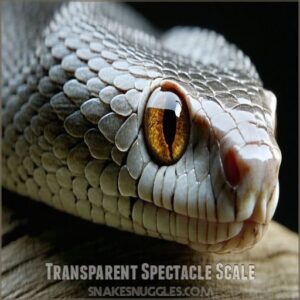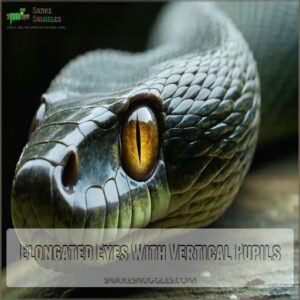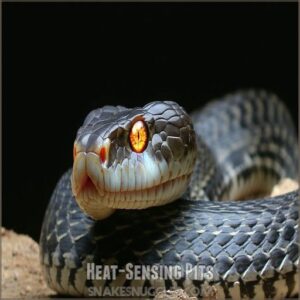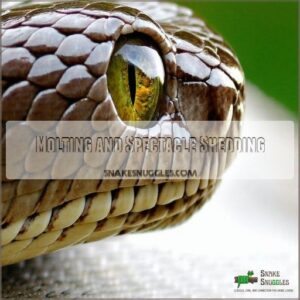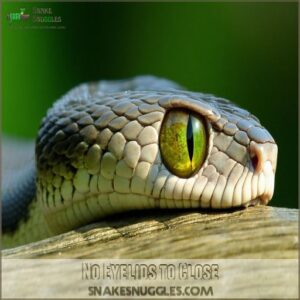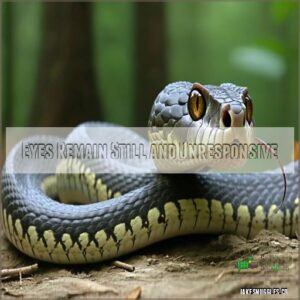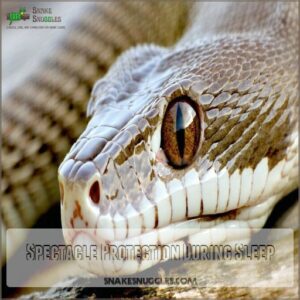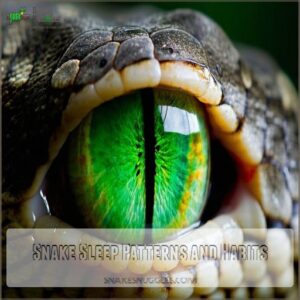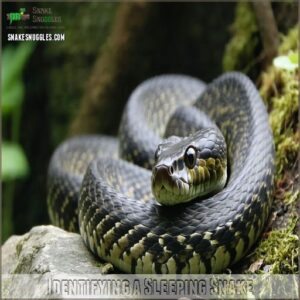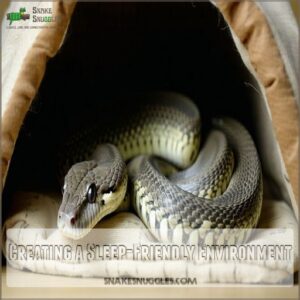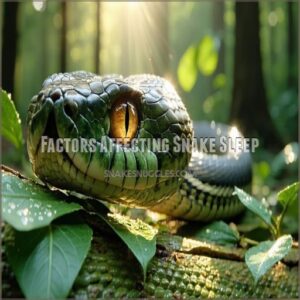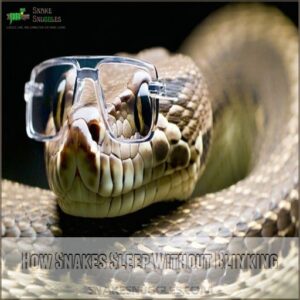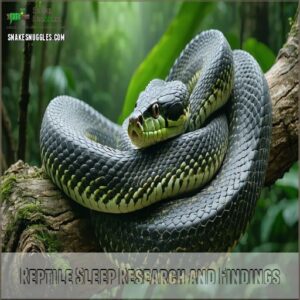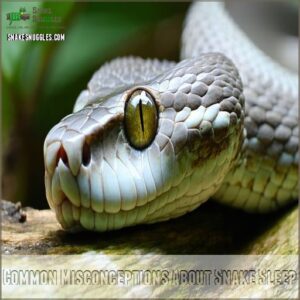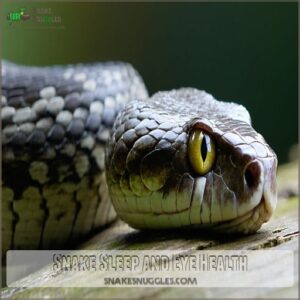This site is supported by our readers. We may earn a commission, at no cost to you, if you purchase through links.

Snakes do sleep with their eyes open because they don’t have eyelids.
Instead, they’re equipped with a transparent scale called a spectacle that protects their eyes like built-in safety goggles.
During sleep, which can last up to 16 hours daily, their eyes remain still and unresponsive.
While we humans need our beauty rest with closed eyes, these remarkable reptiles have evolved this unique adaptation for round-the-clock eye protection.
Their sleep patterns reveal even more fascinating behaviors, especially during seasonal changes and after meals.
Table Of Contents
- Key Takeaways
- Snakes’ Unique Eye Anatomy
- Do Snakes Sleep With Their Eyes Open?
- Snake Sleep Patterns and Habits
- Identifying a Sleeping Snake
- Creating a Sleep-Friendly Environment
- Factors Affecting Snake Sleep
- How Snakes Sleep Without Blinking
- Reptile Sleep Research and Findings
- Common Misconceptions About Snake Sleep
- Snake Sleep and Eye Health
- Frequently Asked Questions (FAQs)
- Conclusion
Key Takeaways
- You’ll find that snakes don’t have eyelids – instead, they’re protected by a transparent scale called a spectacle that acts like built-in safety goggles.
- While your snake’s eyes remain open during sleep, they’re actually unresponsive and still, with their sleep lasting up to 16 hours daily.
- You can tell if your snake is sleeping by looking for a relaxed body posture, slow, rhythmic breathing, and minimal movement, even though their eyes stay open.
- You’ll need to create a dark, quiet, and temperature-controlled environment for your snake to sleep well, since they can’t close their eyes to block out light and disturbances.
Snakes’ Unique Eye Anatomy
You’ll discover that snakes possess a unique eye structure, unlike our own.
They lack eyelids, instead relying on a transparent scale called a spectacle to protect their eyes.
This is why they might seem to always be awake.
Transparent Spectacle Scale
Imagine having built-in sunglasses!
Snakes sport a spectacle, also known as a brille, which is a transparent scale protecting their eyes.
This scale guards against debris and damage, offering eye protection essential for survival.
It doesn’t blink, but it evolves through the molting cycle, shedding with the snake’s skin.
So, shed any worries about their vision being compromised!
Elongated Eyes With Vertical Pupils
Snakes boast elongated eyes with vertical pupils, giving them an edge in night vision like tiny reptilian ninjas.
This eye shape enhances light sensitivity and aids in prey detection, even in low-light conditions.
The unique structure of their eyes, including the presence of transparent spectacle scales and rod cells, further boosts their ability to hunt in low light.
Picture a feline’s gaze, but with more intensity.
This unique adaptation allows snakes to thrive in various environments, showcasing the fascinating complexity of snake anatomy and vision.
Heat-Sensing Pits
You’ve, perhaps unknowingly, marveled at the heat-sensing pits—nature’s marvels on a snake’s face. These pits allow snakes to detect prey, sensing heat and movement even in the dark.
- Located between eyes and nostrils, adding a mysterious flair.
- Instrumental in hunting, offering precise thermal vision.
- Evolved over millions of years for survival.
- Ridiculously sensitive, picking up the tiniest heat changes.
Molting and Spectacle Shedding
Ever wonder why your snake’s eyes look especially clear after a molt?
It’s all about the spectacle shedding.
During the skin shedding process, snakes replace their spectacle scale—the transparent cover over their eyes—ensuring spectacle clarity.
This molting cycle is essential for protecting snake eyelids, keeping their vision sharp, and supporting healthy reptile sleep habits.
Do Snakes Sleep With Their Eyes Open?
You might think snakes sleep with their eyes wide open, but it’s because they don’t have eyelids to shut.
This means their eyes stay still and covered by a protective layer called a spectacle, keeping them safe while they rest.
No Eyelids to Close
In the realm of reptiles, having no eyelids means snakes sleep with eyes open, but don’t worry—they’ve adapted well.
Their eyes are protected by a "spectacle," a transparent scale that acts like goggles, ensuring essential eye protection while catching Z’s.
This protection extends to shielding their eyes from dust and other environmental hazards like spectacles do.
This distinctive trait means their spectacle function replaces eyelids, offering a fascinating twist on reptile sleep and snake vision.
Eyes Remain Still and Unresponsive
So, snakes lack eyelids, right? That means their eyes stay open even while they’re snoozing. But don’t worry, their eyes aren’t wide open and staring. Instead, they remain still and unresponsive, reminiscent of a "snake eye stare" often depicted in popular culture, like in the numerous products available for snake eye stare inspiration. Think of it as a peaceful, sleepy stare.
- Their eye movement is minimal.
- Their gaze is fixed.
- They’re totally out of it.
Spectacle Protection During Sleep
Despite what you might think, snakes sleep with their eyes open, thanks to the spectacle—a protective layer over their eyes.
This spectacle functions like a translucent cover, guarding the eyes during rest.
Regular molting cycles help maintain this protective shield.
Spectacle shedding helps their snake eyes remain healthy, supporting eye care and proper sleep hygiene.
| Aspect | Description | Benefit |
|---|---|---|
| Spectacle Function | Transparent eye cover | Protects during sleep |
| Molting Cycle | Regular shedding for new spectacles | Maintains eye health |
| Eye Care | Protection from debris and injuries | Helps clear snake vision |
Snake Sleep Patterns and Habits
You might think snakes never sleep because their eyes are always open, but their sleep patterns are quite fascinating.
Sleep patterns are unique and snakes even take long naps after meals, akin to how you might feel after Thanksgiving dinner.
Diurnal and Nocturnal Snakes
Whether they’re catching some Z’s during the day or night, snakes’ sleep depends on their activity patterns.
Diurnal snakes, like energetic sunbathers, are active by day and snooze at night.
Nocturnal ones, however, enjoy late-night hunting strategies, stalking their prey in the moonlight.
Their habitat preferences and predator avoidance remind us that snake behavior is quite the fascinating symphony.
Sleep Duration and Frequency
Wondering about your snake’s sleep patterns? They can sleep up to 16 hours daily, but don’t worry, it’s normal! After a big meal, their nap could stretch to 20 hours.
Here’s the scoop on their snooze routine:
- Age Matters: Older snakes may rest longer.
- Diet Influence: Big meals mean extended naps.
- Environmental Factors: Quiet, warm spaces help them relax.
Seasonal Changes in Sleep Patterns
As you explore snake sleep patterns, you’ll notice that seasonal shifts play a big role.
In colder months, some snakes slow down, eyeing a break from their usual hustle.
These changes, often linked to less food intake and cooler temperatures, tweak their patterns.
You might find your reptile buddy adjusting its activity to match these natural cues.
Brumation and Hibernation
Brumation, often confused with hibernation, is a reptilian equivalent that snakes undergo during colder months. This survival strategy isn’t about long, cozy naps; it’s more like a sluggish standby mode. Understanding brumation can help you care better for your snake, ensuring it’s safe and sound during this period.
- Temperature drop triggers brumation
- Lasts for several weeks to months
- Reduced food intake is normal
- Safe, quiet hideouts are essential
Identifying a Sleeping Snake
You can identify a sleeping snake by looking for a relaxed body posture and slow, rhythmic breathing; they’ll be very still and unresponsive, unlike their more active selves.
Relaxed Body Posture
Spotting a sleeping snake isn’t as tricky as it sounds.
Look for a relaxed body posture, giving off a vibe as if it’s fully trusting your care.
This laid-back snake won’t budge, showcasing an impressive ability to snooze deeply without a blink.
Their posture tells a story of complete relaxation, leaving you marveling at this silent mastery of rest.
Slow and Rhythmic Breathing
When identifying a snoozing snake, pay attention to its slow and rhythmic breathing.
This breathing pattern hints at relaxed respiratory health and a typical sleep stage.
A quiet, steady inhale and exhale, like a gentle breeze, shows low oxygen consumption and minimal stress.
It’s nature’s way of saying, "I’m at peace, no sudden moves, please.
Stillness and Unresponsiveness
A snake can seem like it’s playing a very convincing game of freeze tag when it’s asleep.
However, to distinguish this stillness from a lifeless state, look for signs such as unresponsive pupils or a lack of muscle tone, which can indicate a snake is deceased, as outlined in snake death symptoms.
Its stillness and unresponsive nature might make you wonder if it’s pulling a fast one on you.
However, this snake stillness, coupled with slow breathing, reassures you it’s simply resting.
Remember, despite their eyes open, they’re just enjoying a quiet nap.
Distinguishing Brumation From Death
If your snake seems still and unresponsive, you might wonder, "Is it resting or… gone?"
Here’s how to tell: check for signs of life like subtle movement or a slight reaction to touch.
During brumation, a gentle nudge prompts some movement or a slight rise in body temperature.
Unlike hibernation, they’re not completely out—just chilling with eyes open.
Creating a Sleep-Friendly Environment
To give your snake the perfect rest, create a dark, quiet, and warm sleeping area, just like you’d want for a good night’s sleep.
Remember, avoiding bright lights and disturbances helps signal that it’s bedtime, even if your snake won’t close its eyes.
Dark and Quiet Sleeping Area
Knowing your snake’s sleeping style is half the battle!
A sleeping snake looks peaceful, still, and unresponsive.
To help them get a good night’s rest, create the perfect sleep sanctuary.
Here’s what you need:
- A dark enclosure.
- A quiet spot.
- Minimal disturbances.
Think of it as designing a luxurious snake hotel, complete with blackout curtains and a "Do Not Disturb" sign.
Sweet dreams!
Warmth and Temperature Control
Creating the perfect sleep haven for your snake starts with managing temperature.
Using heat lamps effectively can mimic ideal basking spots and establish thermal gradients.
This prevents cold stress, helping your snake sleep soundly.
Remember, their physiology thrives with consistent temperature regulation, so keep it cozy.
Even with eyes open, a toasty environment promotes better rest and content reptile eyes.
Establishing a Routine and Bedtime Cues
You can help your snake settle into a sleep routine by sticking to consistent feeding times, similar to our nightly snack ritual.
Try these tricks: 1. Dim the lighting in their enclosure.
- Play calming music softly.
- Add cozy hiding spots to promote their natural snake behavior.
Respect their sleep cycles to support healthy snake habits and reptile behavior.
Avoiding Disturbances and Bright Lights
Think of snakes like introverts after a busy day—they need a quiet snake habitat to relax.
Bright lights are a no-go, as these creatures appreciate low light conditions.
Snake sleep is best when disturbances are minimized, letting them embrace their nocturnal habits.
Safe handling and awareness of their light sensitivity keep them resting peacefully, eyes open.
Factors Affecting Snake Sleep
When considering factors that affect snake sleep, you’ll find that species, age, and health all play important roles in determining rest patterns.
Just like humans might toss and turn after a big meal or a stressful day, a snake’s food intake and environmental changes can also impact its snooze time.
Species and Age
Just like us, snakes’ sleep patterns vary by species and age.
Some snooze longer, especially older ones or certain breeds known for laziness while others are up and about more.
These species-specific differences mean you might spot a young, energetic corn snake napping less than a hefty python, showing exactly how age-related changes impact snake sleep and behavior.
Health and Illness
Snake health directly impacts sleep.
If your scaly friend seems sleepy all day or won’t wake up, consider a vet visit.
Here are four signs to watch:
- Unusual Lethargy: Not moving much?
- Respiratory Issues: Wheezing sounds?
- Skin Problems: Any strange spots?
- Behavioral Changes: Acting odd?
Catching illness early allows for prompt treatment.
Food and Feeding Schedule
A sick snake’s sleep patterns change, but food also impacts rest. Did you know a big meal can lead to a long snake nap? Feeding frequency matters! To make sure the perfect meal size, check out optimal snake meal size products to cater to your pet’s needs.
Here’s a quick guide:
| Feeding Frequency | Meal Size | Digestion Time (approx.) |
|---|---|---|
| Weekly | Moderate | 2-3 days |
| Bi-weekly | Larger | 4-5 days |
| Monthly | Large (depending on species) | 7-10 days |
Remember, these are guidelines. Your snake’s needs are unique! Observe your snake’s behavior and adjust accordingly. Keep it happy, keep it healthy!
Environmental Changes
When temperature fluctuations or humidity levels change, your snake’s sleep might get a bit restless. Keep its tank conditions steady:
- Control light exposure—too much can mess with their natural rhythms. Since snakes have a protective transparent scale called a brille, or transparent eyelid, it’s important to replicate their natural environment as closely as possible.
- Minimize noise pollution for a peaceful environment.
- Adjust enclosure settings to reflect natural habitat changes.
These tweaks help keep those eyes open and snake behavior calm.
How Snakes Sleep Without Blinking
When you learn that snakes manage to sleep without eyelids, it might surprise you.
They rely on a clear spectacle covering their eyes, keeping them protected while maintaining an unblinking gaze.
Adaptation to Lack of Eyelids
Ever wonder how snakes manage without eyelids? Their spectacular adaptation involves relying on a spectacle scale covering their eyes. This built-in "goggles" setup lets them keep their eyes open even during sleep, providing vision in darkness while ensuring eye protection. The evolution of eyes in these creatures means they never need to blink—talk about staying vigilant 24/7!
| Eyelidless Existence | Vision in Darkness |
|---|---|
| Constant readiness | Nighttime adventurers |
| No blinking needed | Eyes open at all times |
| Spectacle superstition | Protects from debris |
| Nature’s night owls | Seeing’s their superpower |
Spectacle Protection and Maintenance
Your snake’s "spectacle" is like a superhero shield for its eyes—taking blows from debris without blinking.
Keeping this lens in tip-top shape helps maintain solid eye health.
Here’s how you can help:
- Regular spectacle cleaning
- Monitoring the shedding cycle
- Checking for spectacle damage
- Providing a debris-free environment
- Ensuring a calm resting place
A little care goes a long way!
Eye Function During Sleep
Imagine a snake curling up for a nap without blinking.
The spectacle scale acts as a built-in contact lens, shielding their peepers.
Though eyes remain open, their sight dims, like turning down a lamp.
In this eyelidless sleep, all stays safe.
Reptile eye evolution makes sure sleep and sight work seamlessly without sacrificing eye protection or snake physiology.
Reptile Sleep Research and Findings
You’ll find that sleep studies on reptiles like snakes and lizards reveal fascinating differences across species.
These insights enhance our understanding of reptile biology and also offer practical tips for better care and management.
Comparative Study of Snakes and Lizards
Many studies compare snake and lizard sleep. Let’s explore some key differences! Think about these reptile sleep characteristics:
- Eyelid structure: Snakes lack eyelids; lizards generally have them.
- Brumation vs. hibernation: Similar, but with subtle differences in duration and trigger.
- Thermal regulation: Both rely on external heat sources, influencing sleep patterns.
- Defense mechanisms: Sleep postures differ, reflecting their unique vulnerabilities.
Understanding these nuances provides better reptile care.
Sleep Patterns in Different Species
Understanding snake sleep cycles can be like piecing together a reptilian mystery.
Different snake species bring their own quirks to how they sleep—some enjoy sleeping in groups, others prefer solitude.
Environmental impact plays a big role, too.
By studying various snake breeds, scientists explore individual sleep patterns, helping us grasp the fascinating ways snakes rest, eyes open and all.
Implications for Reptile Care and Management
You’ve probably considered how subtle changes in sleep patterns affect your reptile’s well-being.
With snakes snoozing eyes wide open, understanding their sleep can guide effective habitat design, optimize feeding strategies, and reduce stress.
Regularly maintain enclosures to create a tranquil environment, important for hibernation.
By adjusting care routines, you make sure your pet snake enjoys a healthier, more restful life.
Common Misconceptions About Snake Sleep
You might think snakes always stare at you with unblinking eyes, even while napping, but that’s not entirely true.
Despite their lack of eyelids, snakes use a special transparent scale to protect their eyes during sleep, like having permanent sunglasses for some well-deserved shut-eye.
Myths and Misunderstandings
Imagine this: a snake sleeping with its eyes open.
It’s not a spooky tale—just a common misconception about snake behavior.
Without eyelids, snakes rely on a transparent spectacle to protect their eyes, which is why specialized snake eye protection is essential for their care.
This gives the illusion of wide-awake alertness.
So when you’re into snake care, remember they’re resting quietly even if their eyes are "open."
Snake care myths busted!
Facts and Reality
Many believe snakes sleep with their eyes open because they lack eyelids, but that’s not true.
They do enter sleep stages like us, protected by a clear spectacle scale, giving the illusion of alertness.
So, what appears as a wide-eyed stare is just a resting snake.
Remember, their sleep duration can vary with environment and species.
Debunking Common Myths
It’s tempting to believe everything you hear, but snake sleep myths need busting. Here’s what’s true:
- Snakes don’t need eyelids—their spectacle scale protects those peepers.
- Hibernation and sleep differ—snakes do both, but not simultaneously.
- Snake sleep cycles vary by species and environment.
- Sleep myths aside, their restful hours are essential for health.
Snake Sleep and Eye Health
Since snakes lack eyelids, their eye health is especially important during sleep.
Proper handling is essential to prevent injuries and infections, ensuring your scaly friend enjoys many peaceful—and eye-safe—slumbers.
Vulnerability to Eye Damage
While myths swirl around snake sleep, real concerns lie with their eyes.
Without eyelids, snakes face eye damage from debris.
Protecting their unique spectacles is essential.
Consider this a snake’s version of wearing safety goggles 24/7!
Keeping their habitat clean helps prevent infections and keeps their peepers safe.
Prioritize snake eye care to navigate these fascinating creatures’ biological quirks.
Importance of Proper Handling
Handling your snake with care is essential to preserving their delicate eyes. Remember these simple steps to protect your scaly friend:
- Use gentle handling methods; always support the body to reduce stress.
- Avoiding eye injuries by ensuring your hands are clean and free of sharp objects.
- Practice safe handling techniques by staying calm and moving slowly.
Preventing Eye Injuries and Infections
Proper handling sets the stage for preventing snake eye injuries.
Think of eyelidless snakes as needing protective eyewear.
It’s also important to watch for signs of eye problems, such as retained eye caps, which can be caused by low humidity or dehydration.
Hygiene practices like clean hands and a safe enclosure design are your go-to moves.
Avoid scratchy substrates that threaten their snake sleep.
Regular eye checks guarantee your pet stays healthy, because in animal care, a little prevention goes a long way.
Frequently Asked Questions (FAQs)
Do snakes sleep with their eyes open?
Unlike us who close our eyes for a peaceful snooze, snakes don’t have eyelids!
Instead, they’ve got a clear scale called a spectacle that permanently covers their eyes, so they technically always sleep "eyes open".
What causes difficulty opening your eyes after sleep?
Sleep-induced eye discharge, also known as "sleep sand," can make your eyes feel stuck together.
Sleep sand is mucus that your eyes produce while you sleep and dries and crusts, temporarily sealing your eyelids shut.
Do snakes see when they sleep?
No, snakes can’t see while sleeping, even though their eyes appear open.
Spectacles, their transparent eye scales, protect their eyes during rest, but their brain isn’t processing visual information during sleep.
Do corn snakes sleep with their eyes open?
Your corn snake will appear to sleep with open eyes since they lack traditional eyelids.
They’re protected by a clear scale called a spectacle, which stays fixed in place even during rest.
Do reptiles sleep with their eyes open?
Here’s a sight for sore eyes: reptiles can’t close their peepers because they don’t have eyelids!
Instead, they’re equipped with transparent scales called spectacles that protect their eyes while they snooze.
Conclusion
Now you know the truth – snakes aren’t giving you the eternal death stare!
While it’s fascinating that snakes do sleep with their eyes open, it’s simply because they lack eyelids.
Their transparent spectacles protect their eyes 24/7, whether they’re awake or catching those important Z’s.
Understanding these unique sleep patterns and adaptations helps us better care for our scaly friends and appreciate the remarkable ways nature has evolved to meet different species’ needs.

